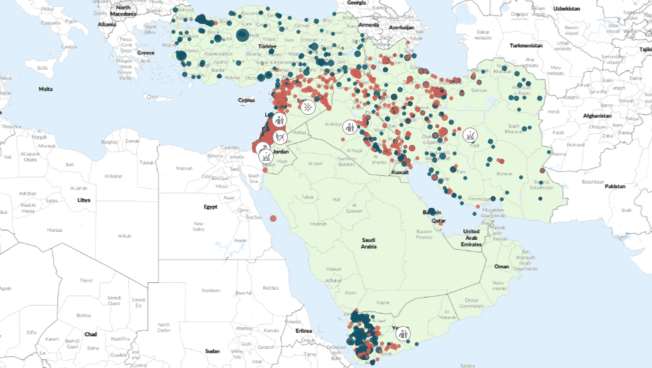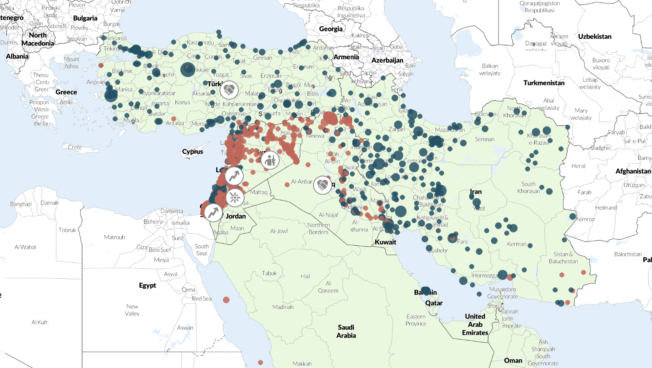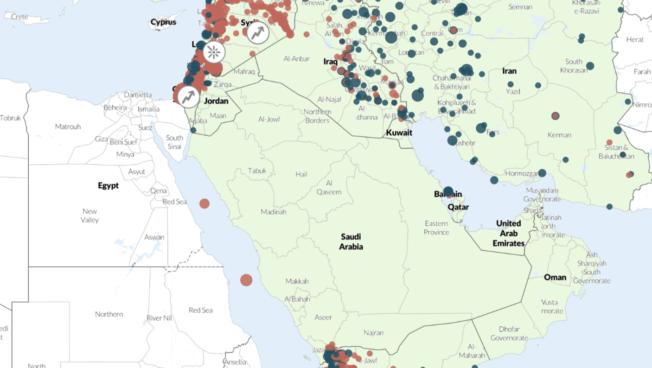Regional Overview
Middle East
March 2024
Posted: 5 April 2024
 Gaza: UN Security Council calls for immediate ceasefire amid looming Israeli ground operation into Rafah
Gaza: UN Security Council calls for immediate ceasefire amid looming Israeli ground operation into Rafah
In March, the number of political violence events and reported fatalities decreased in the Gaza Strip compared to the month prior. In the north of Gaza, the Israel Defense Forces (IDF) completed ground operations in al-Zaytun neighborhood by mid-March before launching a two-week campaign targeting al-Shifa hospital and its surrounding area in the Southern Rimal neighborhood of Gaza City. The IDF had previously taken control of the hospital in November 2023, destroying an underground tunnel network that it claimed was used by Hamas as a command center. Following the IDF’s withdrawal from the city in January, Hamas militants had regrouped and were allegedly operating from inside the hospital.1Patrick Kingsley, ‘Israeli Army Withdraws From Major Gaza Hospital, Leaving Behind a Wasteland,’ New York Times, 2 April 2024 At least 12 armed clashes broke out across the campus during the second half of March, leading to the death of nearly 200 Palestinian militants.
Meanwhile, in Gaza’s southern Khan Yunis governorate, clashes continued, though at reduced rates, in Hamad City, al-Qarara, Abasan al-Kabira, Amal neighborhood, and areas near the Nasser hospital. In Rafah, the IDF continued launching airstrikes, but an anticipated ground invasion did not begin amid intense international pressure — most importantly from the US, which chose not to veto a Gaza ceasefire resolution at the United Nations on 25 March.2Nadeen Ebrahim and Abbas Al Lawati, ‘The US allowed a Gaza ceasefire resolution to pass at the UN. What does that mean for the war?, CNN, 27 March 2024 While Israeli officials insist that the IDF remains determined to invade Rafah,3Times of Israel, ‘Netanyahu maintains IDF will enter Rafah despite international pressure,’ 14 March 2024 where Hamas still has four battalions,4Associated Press, ‘Why Israel is so determined to launch an offensive in Rafah,’ 21 March 2024 the timing and intensity of the operation may yet be influenced by diplomatic efforts. Truce talks between Israel and Hamas resumed in Cairo in early April, in the latest attempt to bring a pause to nearly six months of war in Gaza.
 Iraq: Tribal violence in southern Iraq
Iraq: Tribal violence in southern Iraq
In March, tribal violence reintensified in the southern provinces of Thi Qar, al-Basra, and Maysan following a lull in activity in February. In Thi Qar province, deadly tribal clashes between al-Rumaid and al-Omari tribes on 3 March led to the death of the head of the province’s intelligence and counter-terrorism unit following an intervention by security forces. Iraqi security forces clashed with militants from the involved tribes and arrested 123 individuals. The arrests triggered subsequent protests demanding their release. The same warring tribes have been in conflict since April 2023, resulting in dozens of casualties and approximately 115 families displaced,5Al-Quds Al-Arabi, ‘Dhi Qar: A tribal conflict causes the displacement of 115 families,’ 29 September 2023 despite reaching a truce mediated by prominent religious leader Ali al-Sistani in October 2023.6Staff, ‘Al Omar and Al-Rumaid respond to Al-Sistani’s mediation after a bloody dispute for months,’ Almada Paper, 3 October 2023 In addition to Thi Qar, at least three were wounded in tribally motivated clashes and attacks on civilians reportedly left five people dead in al-Basra and Maysan provinces.
 Lebanon and Syria: Israel escalates its campaign against Hezbollah
Lebanon and Syria: Israel escalates its campaign against Hezbollah
Fears over the Israel and Hamas conflict spilling over into a broader regional war continue to run high. While attacks and counter-attacks involving United States forces in Iraq and Syria nearly ceased in March, hostilities between Israel and Iran-backed members of the ‘axis of resistance’ in Syria and Lebanon continued to escalate. On 29 March, the IDF conducted its deadliest attack in Syria in years, hitting multiple targets, including a Hezbollah rocket depot in Aleppo. The airstrikes reportedly left 36 regime soldiers, seven Hezbollah fighters, and another three pro-Iran militants dead. Israel has carried out hundreds of strikes on targets in government-controlled areas in Syria in recent years, but its military campaign against Iran-backed groups has intensified since 7 October and may now be increasingly focusing on Hezbollah and its assets.
Hezbollah and Israel have engaged in daily exchanges of fire along the Israeli-Lebanese border in the past six months. The IDF killed at least two senior commanders of Hezbollah’s anti-tank missile unit in drone strikes on 29 and 31 March in southern Lebanon. On 11 and 12 March, Israeli jets conducted several airstrikes deep inside Lebanon, while on 26 March, Hezbollah positions were targeted in northeastern Lebanon near Ras Baalbek and Hermel. These events mark the deepest raids inside Lebanon since the October hostilities broke out. In a recent interview, Israel’s Defense Minister Yoav Gallant suggested that the IDF was expanding its campaign against Hezbollah and “turning from defending to pursuing” the Lebanese Shiite group.7Emanuel Fabian, ‘ Hinting at Syria strikes, Gallant says Israel will “expand the campaign” against Hezbollah,’ Times of Israel, 29 March 2024
 Syria: Protests break out in rebel-held areas
Syria: Protests break out in rebel-held areas
In northwestern Syria, growing public anger toward Hayat Tahrir al-Sham (HTS) triggered more than 80 protests in at least 28 towns and villages across rebel-held areas in Idleb and Aleppo provinces in March. The protesters denounced HTS and demanded its leader, Muhammad al-Jawlani, be overthrown. The protests were sparked by the torture and killing of a member of the Jaysh al-Ahrar opposition group in an HTS prison on 24 February. The arrest and killing of the fighter was part of an HTS campaign to crack down on alleged collaborators with the Syrian regime and foreign entities. HTS launched the campaign last year, arbitrarily detaining and disappearing hundreds of civilians and fighters, including commanders of HTS. HTS, formerly known as Jabhat al-Nusra, is the largest Sunni Islamist political and militant group operating in northwestern Syria. Since 2020, the group has controlled the rebel-held areas in Idleb, which is home to more than 3 million people — the majority of whom are displaced from other parts of Syria. The group also operates in parts of Aleppo’s western countryside, the Lattakia mountains, and al-Ghab Plain in northwestern Hama.
 Yemen: Houthi attacks in the Red Sea and the Gulf of Aden lead to their first fatalities
Yemen: Houthi attacks in the Red Sea and the Gulf of Aden lead to their first fatalities
The increased intensity of Houthi maritime attacks in the second half of February continued into March. On 6 March, Houthi attacks led to their first fatalities, killing three crew members of the True Confidence bulk carrier in the Gulf of Aden. This was followed by the largest swarm attack against US warships to date on 9 March, with Houthi forces claiming to have launched 37 drones at US warships in the Red Sea and the Gulf of Aden.8X @army21ye, 9 March 2024The US claimed that a total of 28 drones were shot down in the two waterways,9X @CENTCOM, 9 March 2024 in an engagement that involved the British, Danish, French, and US navies. Throughout the month, Houthi attacks were also intercepted by the German, Greek, and Italian navies, evidence of increased European Union engagement following the launch of Operation Aspides in February.
In the second half of March, Houthi attacks saw a notable decline, despite the Houthi leadership vowing to extend attacks to the Indian Ocean and threatening traffic through the Cape of Good Hope on 14 March.10Reuters, ‘Leader of Yemen’s Houthis vows to attack more shipping lanes,’ 14 March 2024 Almost two-thirds of Houthi maritime attacks for the whole month were recorded between 1 and 15 March. This decline also coincided with a drop in US strikes on Houthi weaponry and associated infrastructure inside Yemen, possibly indicating that the Houthi arsenal is depleting or that back-channel talks are taking place.
For more, see the Red Sea attacks interactive map as part of the Yemen Conflict Observatory.
 غزة: مجلس الأمن الدولي يدعو إلى وقف فوري لإطلاق النار وسط عملية برية إسرائيلية تلوح في الأفق في رفح
غزة: مجلس الأمن الدولي يدعو إلى وقف فوري لإطلاق النار وسط عملية برية إسرائيلية تلوح في الأفق في رفح
في شهر مارس/آذار، انخفض عدد أحداث العنف السياسي والوفيات المبلغ عنها في قطاع غزة مقارنة بالشهر السابق. ففي شمال غزة، أكمل جيش الدفاع الإسرائيلي العمليات البرية في حي الزيتون في منتصف مارس/آذار قبل إطلاق حملة لمدة أسبوعين تستهدف مستشفى الشفاء والمنطقة المحيطة به في حي الرمال الجنوبي في مدينة غزة. وكان الجيش الإسرائيلي قد سيطر سابقًا على المستشفى في نوفمبر/تشرين الثاني 2023، ودمر شبكة أنفاق تحت الأرض ادعى أنها كانت تستخدمها حماس كمركز للقيادة. وبعد انسحاب الجيش الإسرائيلي من المدينة في يناير/كانون الثاني، أعاد مقاتلو حماس تجميع صفوفهم وزُعم أنهم كانوا يعملون من داخل المستشفى.[1] واندلع ما لا يقل عن 12 اشتباكًا مسلحًا في جميع أنحاء حرمه خلال النصف الثاني من شهر مارس/آذار، مما أدى إلى مقتل ما يقرب من 200 مسلح فلسطيني.
وفي الوقت نفسه، في محافظة خان يونس جنوب غزة، استمرت الاشتباكات، ولكن بوتيرة منخفضة، في مدينة حمد، والقرارة، وعباسان الكبيرة، وحي الأمل، والمناطق القريبة من مستشفى ناصر. وفي رفح، واصل الجيش الإسرائيلي شن الغارات الجوية، لكن الغزو البري المتوقع لم يبدأ وسط ضغوط دولية مكثفة – وعلى رأسها الولايات المتحدة، التي اختارت عدم استخدام حق النقض ضد قرار وقف إطلاق النار في غزة في الأمم المتحدة في 25 مارس/آذار.[2] وفي حين يصر المسؤولون الإسرائيليون على أن الجيش الإسرائيلي لا يزال مصممًا على غزو رفح،[3] حيث لا تزال حماس تمتلك أربع كتائب،[4] إلا أن توقيت العملية وحدتها قد يتأثران بالجهود الدبلوماسية. واستؤنفت محادثات الهدنة بين إسرائيل وحماس في القاهرة في أوائل ابريل/نيسان، في أحدث محاولة لوقف ما يقرب من ستة أشهر من الحرب في غزة.
[1] باتريك كينجسلي، “الجيش الإسرائيلي ينسحب من مستشفى كبير في غزة، تاركًا وراءه أرضًا قاحلة”، نيويورك تايمز، 2 ابريل/نيسان 2024
[2] نادين إبراهيم وعباس اللواتي، “سمحت الولايات المتحدة بتمرير قرار وقف إطلاق النار في غزة في الأمم المتحدة. ماذا يعني ذلك بالنسبة للحرب؟ ، سي إن إن (CNN)، 27 مارس/آذار 2024
[3] تايمز أوف إسرائيل، “نتنياهو يؤكد أن جيش الدفاع الإسرائيلي سيدخل رفح على الرغم من الضغوط الدولية”، 14 مارس/آذار 2024
[4] أسوشيتد برس، “لماذا إسرائيل مصممة جدًا على شن هجوم في رفح”، 21 مارس/آذار 2024
 العراق: العنف العشائري في جنوب العراق
العراق: العنف العشائري في جنوب العراق
في مارس/آذار، اشتدت أعمال العنف العشائري من جديد في المحافظات الجنوبية مثل ذي قار والبصرة وميسان بعد هدوء فعلي في فبراير/شباط. وفي محافظة ذي قار، أدت الاشتباكات العشائرية الدامية بين عشيرتي آل رميض وآل عمر في 3 مارس/آذار إلى مقتل رئيس وحدة الاستخبارات ومكافحة الإرهاب في المحافظة بعد تدخل قوات الأمن. واشتبكت قوات الأمن العراقية مع مسلحين من العشائر المتورطة واعتقلت 123 فردًا. وأدت الاعتقالات إلى احتجاجات لاحقاً تطالب بالإفراج عنهم. وتخوض العشائر المتحاربة نفسها نزاعًا منذ ابريل/نيسان 2023، مما أدى إلى سقوط عشرات الضحايا ونزوح حوالي 115 عائلة،[1] وذلك على الرغم من التوصل إلى هدنة توسط فيها المرجع الديني البارز علي السيستاني في أكتوبر/تشرين الأول 2023.[2] وبالإضافة إلى ذي قار، أصيب ما لا يقل عن ثلاثة أشخاص في اشتباكات بدوافع عشائرية وهجمات على المدنيين أسفرت عن مقتل خمسة أشخاص في محافظتي البصرة وميسان.
[1] القدس العربي، “ذي قار: نزاع عشائري يتسبب في نزوح 115 عائلة”، 29 سبتمبر/أيلول 2023
[2] ديوان، “آل عمر وآل رميض يستجيبان لوساطة السيستاني بعد نزاع دموي منذ أشهر”، جريدة المدى، 3 أكتوبر/تشرين الأول 2023
 لبنان وسوريا: إسرائيل تصعّد حملتها ضد حزب الله
لبنان وسوريا: إسرائيل تصعّد حملتها ضد حزب الله
لا تزال المخاوف من امتداد الصراع بين إسرائيل وحماس إلى حرب إقليمية أوسع تتصاعد. ففي حين أن الهجمات والهجمات المضادة التي تشارك فيها قوات الولايات المتحدة في العراق وسوريا توقفت تقريبًا في مارس/آذار، استمرت الأعمال العدائية بين إسرائيل وأعضاء “محور المقاومة” المدعومين من إيران في سوريا ولبنان في التصعيد. ففي 29 مارس/آذار، شن الجيش الإسرائيلي هجومه الأكثر دموية في سوريا منذ سنوات، حيث أصاب أهدافًا متعددة، بما في ذلك مستودع صواريخ تابع لحزب الله في مدينة حلب. وبحسب ما ورد أسفرت الغارات الجوية عن مقتل 36 جنديًا من جنود النظام وسبعة مقاتلين من حزب الله وثلاثة مقاتلين آخرين موالين لإيران. ونفذت إسرائيل مئات الضربات على أهداف في المناطق التي تسيطر عليها الحكومة في سوريا في السنوات الأخيرة، لكن حملتها العسكرية ضد الجماعات المدعومة من إيران اشتدت منذ 7 أكتوبر/تشرين الأول، وربما تركز الآن بشكل متزايد على حزب الله وأصوله.
وقد انخرط حزب الله وإسرائيل في تبادل يومي لإطلاق النار على طول الحدود الإسرائيلية اللبنانية في الأشهر الستة الماضية. وقتلت قوات الدفاع الإسرائيلية (IDF) اثنين على الأقل من كبار قادة وحدة الصواريخ المضادة للدبابات التابعة لحزب الله في غارات بطائرات بدون طيار يومي 29 و31 مارس/آذار في جنوب لبنان. وفي 11 و12 مارس/آذار، شنت الطائرات الإسرائيلية عدة غارات جوية في عمق لبنان، بينما استهدفت مواقع حزب الله في 26 مارس/آذار في شمال شرق لبنان بالقرب من رأس بعلبك والهرمل. وتمثل تلك الأحداث أعمق الغارات داخل لبنان منذ اندلاع الأعمال العدائية في أكتوبر/تشرين الأول. وفي مقابلة حديثة، أشار وزير الدفاع الإسرائيلي يوآف غالانت إلى أن الجيش الإسرائيلي يوسع حملته ضد “حزب الله” و “يتحول من الدفاع إلى ملاحقة” الجماعة الشيعية اللبنانية.[1]
[1] إيمانويل فابيان، “ملمحًا إلى الضربات في سوريا، يقول غالانت إن إسرائيل “ستوسع الحملة” ضد حزب الله”، تايمز أوف إسرائيل، 29 مارس/آذار 2024
 سوريا: اندلاع احتجاجات في المناطق التي يسيطر عليها المتمردون
سوريا: اندلاع احتجاجات في المناطق التي يسيطر عليها المتمردون
في شمال غرب سوريا، أثار الغضب الشعبي المتزايد تجاه هيئة تحرير الشام (HTS) أكثر من 80 احتجاجًا في ما لا يقل عن 28 بلدة وقرية في المناطق التي يسيطر عليها المتمردون في محافظتي إدلب وحلب في مارس/آذار. وشجب المتظاهرون هيئة تحرير الشام وطالبوا بالإطاحة بقائدها محمد الجولاني. واندلعت الاحتجاجات بسبب تعذيب وقتل أحد أعضاء جماعة جيش الأحرار المعارضة في سجن هيئة تحرير الشام في 24 فبراير/شباط. وكان اعتقال وقتل ذلك المقاتل جزءًا من حملة هيئة تحرير الشام لقمع المتعاونين المزعومين مع النظام السوري والكيانات الأجنبية. وأطلقت هيئة تحرير الشام الحملة العام الماضي، حيث قامت باعتقال وإخفاء مئات المدنيين والمقاتلين بشكل تعسفي، بما في ذلك قادة في هيئة تحرير الشام نفسها. وهيئة تحرير الشام، المعروفة سابقًا باسم جبهة النصرة، هي أكبر جماعة سياسية إسلامية سنية مسلحة في شمال غرب سوريا. فمنذ عام 2020، سيطرت الجماعة على المناطق التي يسيطر عليها المتمردون في إدلب، والتي تضم أكثر من 3 ملايين شخص – غالبيتهم من النازحين من أجزاء أخرى من سوريا. كما تنتشر الجماعة في أجزاء من ريف حلب الغربي وجبال اللاذقية وسهل الغاب في شمال غرب حماة.
 اليمن: هجمات الحوثيين في البحر الأحمر وخليج عدن تؤدي إلى وفيات للمرة الأولى
اليمن: هجمات الحوثيين في البحر الأحمر وخليج عدن تؤدي إلى وفيات للمرة الأولى
استمرت الكثافة المتزايدة للهجمات البحرية الحوثية في النصف الثاني من فبراير/شباط حتى مارس/آذار. ففي 6 مارس/آذار، أدت هجمات الحوثيين إلى أول حالة وفاة عندما أسفر هجوم عن مقتل ثلاثة من أفراد طاقم ناقلة البضائع ترو كونفيدنس (True Confidence) في خليج عدن. وأعقب ذلك أكبر هجوم على السفن الحربية الأمريكية حتى الآن في 9 مارس/آذار، حيث ادعت قوات الحوثيين أنها أطلقت 37 طائرة بدون طيار على السفن الحربية الأمريكية في البحر الأحمر وخليج عدن.[1] وزعمت الولايات المتحدة أنه تم إسقاط ما مجموعه 28 طائرة بدون طيار في الممرين المائيين،[2] في اشتباك شاركت فيه القوات البحرية البريطانية والدنماركية والفرنسية والأمريكية. وعلى مدار الشهر، تم اعتراض هجمات الحوثيين أيضًا من قبل القوات البحرية الألمانية واليونانية والإيطالية، وهو دليل على زيادة مشاركة الاتحاد الأوروبي بعد إطلاق عملية أسبيدس (Aspides) في فبراير/شباط.
في النصف الثاني من شهر مارس/آذار، شهدت هجمات الحوثيين انخفاضًا ملحوظًا، على الرغم من تعهد القيادة الحوثية بتوسيع الهجمات إلى المحيط الهندي وتهديد حركة المرور عبر رأس الرجاء الصالح في 14 مارس/آذار.[3] وسُجل ما يقرب من ثلثي إجمالي عدد الهجمات البحرية الحوثية طوال الشهر بين 1 و 15 مارس/آذار. وتزامن هذا الانخفاض أيضًا مع انخفاض الضربات الأمريكية على أسلحة الحوثيين والبنية التحتية المرتبطة بها داخل اليمن، مما قد يشير إلى أن ترسانة الحوثيين آخذة في النضوب أو أن هناك محادثات جارية عبر القنوات الخلفية.
للمزيد، أنظرالخريطة التفاعلية لهجمات البحر الأحمر كجزء من مرصد الصراع في اليمن.
[1] منصة X حساب army21ye@، في 9 مارس/آذار 2024
[2] منصة X حساب CENTCOM@، في 9 مارس/آذار 2024
[3] رويترز، “زعيم الحوثيين في اليمن يتعهد بمهاجمة المزيد من ممرات الشحن”، 14 مارس/آذار 2024
See More
See the Codebook and the User Guide for an overview of ACLED’s core methodology. For additional documentation, check the Resource Library. Region-specific methodology briefs can be accessed below.
Links:







